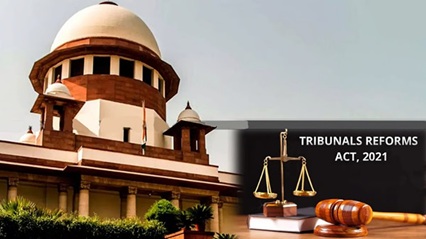Prelims: (Polity + CA)
Mains: (GS 2 – Polity & Governance/Constitution) |
Why in the News ?
The Supreme Court of India has struck down several provisions of the Tribunal Reforms Act, 2021, declaring them unconstitutional for violating judicial independence, separation of powers, and constitutional supremacy.
The Court also directed the Union Government to set up the long-pending National Tribunal Commission (NTC) within four months.

Background: Evolution of Tribunal Reforms in India
- Tribunals were introduced to provide speedy, specialised, and less formal adjudication.
- Over time, concerns arose regarding excessive executive control, short tenures, and poor infrastructural support.
- The Supreme Court, through multiple judgments (Rojer Mathew 2019, Madras Bar Association 2020 & 2021), laid down strict guidelines to secure tribunal independence.
- Despite this, the Tribunal Reforms Act, 2021 reintroduced provisions that were previously struck down, prompting renewed litigation.
Overview of the Tribunal Reforms Act, 2021
The Act aimed to revamp tribunal functioning but drew criticism for reinforcing executive dominance.
Key Provisions
- Minimum age of 50 years for appointment as tribunal member.
- Four-year tenure, with the possibility of reappointment.
- Search-cum-Selection Committee with two Central Government Secretaries — often from ministries that appear as litigants before the tribunal.
- Executive powers to frame rules on appointments, service conditions, salaries, and removal.
- Abolished nine specialised tribunals, shifting their work to High Courts.
These provisions had earlier been invalidated by the Supreme Court but were reintroduced with minor modifications.
Supreme Court’s Core Findings
A Bench led by CJI B.R. Gavai and Justice K. Vinod Chandran found the Act to be a “legislative override” that attempted to undo judicial directions.
1. Judicial Independence
- Tribunals perform judicial functions; hence executive influence in appointments undermines neutrality.
- Government, being a frequent litigant, cannot control tenure, salaries, or selections.
2. Separation of Powers
- Parliament cannot re-enact provisions that the Court has already struck down.
- Judicial directions cannot be bypassed by superficial legislative changes.
3. Constitutional Supremacy
- “The Constitution is what the Court says it is.”
- The Court reiterated that judicial review is a basic feature and cannot be undermined.
Key Provisions Struck Down
The Supreme Court invalidated provisions that:
- Set minimum age of 50 years for appointment.
- Gave the Centre power to fix tenure, age limits, and service conditions.
- Restricted tenure to four years, undermining continuity.
- Included government secretaries on the selection committee.
- Gave excessive rule-making authority to the executive.
These were seen as direct attempts to dilute tribunal autonomy.
Direction to Establish the National Tribunal Commission (NTC)
The Court ordered the Union Government to set up the National Tribunal Commission, envisioned as an independent oversight body to:
- Handle tribunal member appointments,
- Regulate service conditions,
- Oversee administration and infrastructure,
- Ensure uniformity across tribunals,
- Reduce executive involvement.
The Court termed the NTC an “essential structural safeguard”.
Issues with the 2021 Act Highlighted by Petitioners
Petitioners (Madras Bar Association & Jairam Ramesh) argued:
- The Act attempted a “sly revival” of unconstitutional provisions.
- Executive dominance compromises independence as the government is the largest litigant.
- Reforms were passed without meaningful debate.
- Abolition of nine tribunals increased pressure on ** already overburdened High Courts**.
The Supreme Court largely concurred with these views.
Significance of the Judgment
- Reinforces judicial checks on legislative overreach.
- Protects tribunals from executive interference.
- Strengthens citizens’ access to independent justice.
- Sends a clear message that non-compliance with constitutional judgments is unacceptable.
- Re-establishes constitutional balance among legislature, executive, and judiciary.
Challenges Ahead
- Establishing the National Tribunal Commission requires cross-ministerial coordination.
- High Courts may see more backlog until tribunal vacancies are filled.
- Future amendments must strictly adhere to Court guidelines.
- Ensuring transparent, prompt appointments and adequate infrastructure remains essential.
|
FAQs
1. Why did the Supreme Court strike down provisions of the Tribunal Reforms Act, 2021?
Because the Act reintroduced provisions previously held unconstitutional, violating judicial independence and the principle of separation of powers.
2. What constitutional principles were central to the judgment?
Judicial independence, separation of powers, and constitutional supremacy — all part of the basic structure.
3. What is the National Tribunal Commission (NTC)?
A proposed independent body to oversee tribunal appointments, administration, service conditions, and infrastructure.
4. Why was the minimum age requirement of 50 years invalidated?
The Court held that it reduced the pool of eligible candidates and allowed the executive to control who enters the tribunal system.
5. How does the judgment affect tribunal functioning in India?
It strengthens tribunal autonomy, reduces executive dominance, and ensures that tribunals remain impartial adjudicatory bodies.
|



